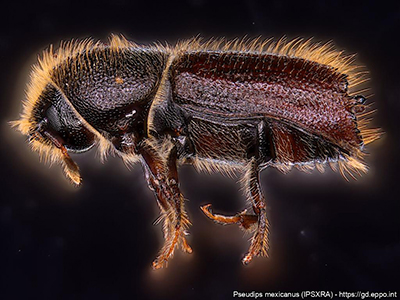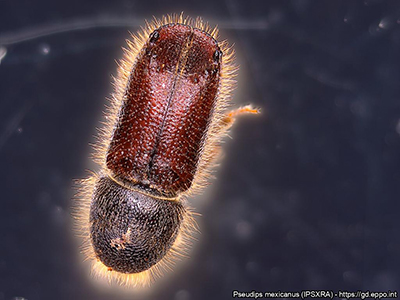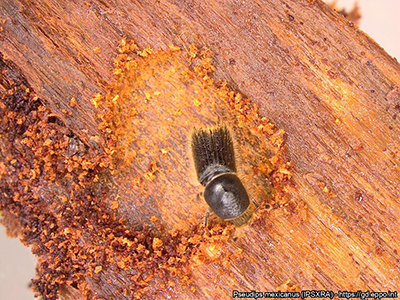
EPPO Alert List – Pseudips mexicanus (Coleoptera: Curculionidae: Scolytinae)
Monterey pine engraver
Why
Pseudips mexicanus (Coleoptera: Curculionidae: Scolytinae - Monterey pine engraver) is a Central American bark beetle of pine trees. It was recently recorded for the first time out of its native range: it was trapped in Ireland (EPPO RS 2024/004) and intercepted in trade. Considering these recent findings in different parts of the world, the EPPO Secretariat considered that P. mexicanus could usefully be added to the EPPO Alert List. Since the addition of P. mexicanus to the EPPO Alert List, a taxonomic revision of the genus Pseudips has taken place. It concluded that P. mexicanus and P. radiatae are two distinct species, and that P. mexicanus is restricted to Mexico and Guatemala, and that records from the USA and Canada correspond to P. radiatae. The specimens trapped in Ireland have been confirmed to be P. mexicanus.

Pseudips mexicanus female (lateral view)
Courtesy: Robyn Earl (Department of Agriculture, Food and the Marine, Ireland)

Pseudips mexicanus female (dorsal view)
Courtesy: Robyn Earl (Department of Agriculture, Food and the Marine, Ireland)

Pseudips mexicanus female
Courtesy: Robyn Earl (Department of Agriculture, Food and the Marine, Ireland)
Where
P. mexicanus originates from Mexico and Guatemala.
EPPO Region: Ireland (trapped, no breeding population has been found).
North America: Mexico.
Central America: Guatemala.
On which plants
P. mexicanus has been recorded attacking a wide range of pine tree species (Pinus spp.) in its native region, including some species that are widely planted in the EPPO region such as P. ponderosa.
Damage
P. mexicanus is a bark beetle. Damage is due to the galleries under the bark where the pest reproduces, and larvae develop. Reddish sawdust can be observed at the surface of the bark. P. mexicanus is mainly reported to infest weakened trees but can also be a primary pest causing death of small to medium size trees. P. mexicanus has up to 7 in Mexico. Adults are 3.5 to 5 mm long, bright dark brown. There are 4 larval stages. The species can overwinter in both larval and adult stages.
Dissemination
Flight of adults is probably the main means of movement and dispersal to new plants and new areas over short distances but specific data on flying distance is lacking. Over long distances, P. mexicanus can be transported on plant material.
Pathways
Host plants for planting, wood, wood chips, wood packaging material, bark. P. mexicanus has been intercepted in trade on wood in the USA. It may be noted that in many EPPO countries (including the EU) requirements already apply to relevant commodities (e.g. prohibition of import of conifer wood and plants for planting over 3 m in height, originating from non-European countries).
Possible risks
P. mexicanus can attack a wide range of pine species that are widely planted in the EPPO region, though attacks on native European pines have not yet been documented. Although this is not documented for P. mexicanus, bark beetles may also act as vectors of pathogens: for example in California (US), the related species P. radiatae has been shown to transmit Fusarium subglutinans, causing pitch canker. P. mexicanus has been intercepted in trade, thus showing that pathways of entry do exist, but more data on its biology is needed to evaluate its potential of establishment in the EPPO region.
Sources
Atkinson T (2024) Bark and ambrosia beetles of the Americas. Available online: https://www.barkbeetles.info/index.php
Cibrián Tovar D, Méndez Montiel JT, Campos Bolaños R, Yates HO, Flores Lara J (1995) Forest insects of Mexico. Universidad Autónoma Chapingo, Chapingo, Mexico, pp. 302-303.
Cognato AI, Smith SM (2024) Taxonomic review of Pseudips Cognato (Coleoptera: Curculionidae: Scolytinae: Ipini) inferred from morphology and a DNA-based phylogeny. The Coleopterists Bulletin 78(2), 239-254.
Fox JW, Wood DL, Koehler CS, O’keefe ST (1991) Engraver beetles (Scolytidae: Ips species) as vectors of the pitch canker fungus, Fusarium subglutinans. The Canadian Entomologist 123(6), 1355-1367.
Haack RA, Rabaglia RJ (2013) Exotic bark and ambrosia beetles in the USA: potential and current invaders. In Potential invasive pests of agricultural crops 2013 (pp. 48-74).
NPPO of Ireland (2024-10). A map of the demarcated area is available at: https://www.gov.ie/en/publication/b62ba-monterey-pine-engraver-pseudips-mexicanus-discovered-in-co-clare/
Robyn Earl, NPPO of Ireland, personal communication (2024-07).
Smith GD, Carroll AL, Lindgren BS (2009) Life history of a secondary bark beetle, Pseudips mexicanus (Coleoptera: Curculionidae: Scolytinae), in lodgepole pine in British Columbia. The Canadian Entomologist 141(1),56-69.
EPPO RS 2024/035, 2024/194, 2024/219
